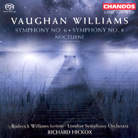December 2003
The Eighth Symphony has no program and is altogether a much happier work. It demonstrated the full range of a modern orchestra, too. The second movement, Scherzo alla marcia, is scored for winds only. One often finds it played out of context on band concert programs. The third movement, an elegiac Cavatina, is scored only for strings, whereas the last movement, scored for full orchestra, spotlights the percussion section. It employs, as the composer stated "all the available hitting instruments which can make a definite note," which means bells, xylophone, timpani, vibraphone, even tuned gongs, similar to those used in Puccini’s Turandot. The disc is filled out with the premiere recording of the Nocturne, a setting of Walt Whitman’s Whispers of Heavenly Death. It is an exceptionally evocative work, wonderfully sung by Roderick Williams and lovingly accompanied by Richard Hickox and the Orchestra’s superb musicians. Throughout this piece and the symphonies, Hickox again proves that he is possibly the only living conductor worthy of inheriting the performance mantle of Sir Adrian Boult, who was the definitive conductor of Vaughan Williams’ music. The recorded sound is good, but is not of demonstration caliber. This is unfortunate, considering the fact that the Eighth Symphony is a demonstration piece. It seems recorded from a distance, say row T, which prohibits some detail from being heard as clearly as many might prefer. Overall, this is polite sound, clean and well balanced, but not close enough up and personal to convey either the savage menace of the Sixth Symphony or the extreme musical color palette of the Eighth. The percussion instruments in the Finale of the Eighth, ring through with great clarity, but the woodwinds could use more presence. The multichannel version is to be greatly preferred, the two-channel version sounding flat by comparison. The recording of Symphony No. 8 conducted by Sir John Barbirolli, who gave the first performance, is really still to be preferred and is available on a magnificently restored CD from Dutton Laboratories. Its definition is surpassed by the SACD’s advanced resolution, but it is closer up and far more exciting. GO BACK TO: |
 Vaughan Williams - Symphonies 6 and 8, Nocturne for Voice and
Orchestra
Vaughan Williams - Symphonies 6 and 8, Nocturne for Voice and
Orchestra Vaughan Williams began composing his grim, determined Sixth
Symphony during the last days of World War II, completing it in the conflict’s
aftermath. Critics have tried, for years, to ascribe programmatic war elements to it, but
the composer always staunchly denied any such connection. Still, it is hard not to think
of war when hearing this mighty composition. It opens with an explosion of sound before
settling down to more lyrical theme. The second movement is underpinned by a constant
three-note motif played by trumpets and drums, which becomes like shattering hammer
strokes threatening to destroy the rest of the music. The third movement is a bizarre
instrumental maelstrom, featuring saxophones, and the last movement never rises above a
whisper, surely suggesting a landscape of destruction and desolation. The movement
dissolves in a pianissimo in which the final key is in doubt, suggesting that the future
is unknown and can go one way or the other.
Vaughan Williams began composing his grim, determined Sixth
Symphony during the last days of World War II, completing it in the conflict’s
aftermath. Critics have tried, for years, to ascribe programmatic war elements to it, but
the composer always staunchly denied any such connection. Still, it is hard not to think
of war when hearing this mighty composition. It opens with an explosion of sound before
settling down to more lyrical theme. The second movement is underpinned by a constant
three-note motif played by trumpets and drums, which becomes like shattering hammer
strokes threatening to destroy the rest of the music. The third movement is a bizarre
instrumental maelstrom, featuring saxophones, and the last movement never rises above a
whisper, surely suggesting a landscape of destruction and desolation. The movement
dissolves in a pianissimo in which the final key is in doubt, suggesting that the future
is unknown and can go one way or the other.